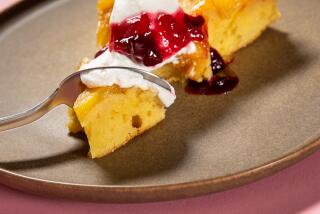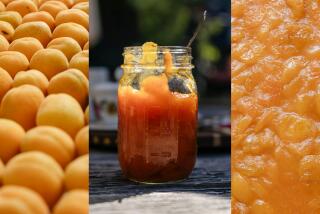Magically transformed
- Share via
ALCHEMISTS have tried for centuries to transform base metals into gold -- unsuccessfully, at least as far as we know. But it’s a lovely concept: Take the common and uninspiring -- lead, copper, prunes -- and change it into something glorious.
Prunes?
Though dried fruit can be tasty right out of the box -- the lunchbox anyway -- it’s even better with a little transformation. But you don’t need medieval textbooks to do it; all you need is a well-stocked pantry, or even better, a good liquor cabinet.
Because to transform dried fruit from an ordinary snack into something quite astonishing, all you need to do is to macerate it -- soak it, that is, preferably in something interesting.
Maceration is really just a nice Latinate word for soaking a solid food in liquid, usually an alcohol. In the case of dried fruit, what happens is quite magical: The fruit, highly concentrated already, absorbs the liquid and effectively rejuvenates.
The flavors of the liquid meld with those of the fruit, creating an entirely new component with a different texture and entirely different flavor profile than you started with.
You can macerate currants in Bourbon, or soak apricots in tea. You can simmer dried figs in red wine and vanilla, or soak prunes in Armagnac.
What you use to macerate the fruit in depends on how you want the flavors to work: Different kinds of tea, wines, fruit juices, eaux de vie, liquors and liqueurs, even more exotic things like orange flower water or rosewater, all add different flavors to the fruit, as well as depth and complexity.
The fruit can be used in savory dishes, such as braises and pilafs, but where this method really shines is in desserts. The condensed flavors of the fruit blend with the sharper tones of the liquid -- especially if you use something with alcohol or tannin -- which not only adds dimension, but cuts the sweetness. The key in some of the best combinations is the tension between the flavors and the textures.
Bread pudding, like this one from Simone Beck, is a perfect example of this kind of tension. The thick whole fruit -- apricots and prunes redolent of red wine and cinnamon -- is the textural opposite of the baked country bread. The flavors all blend gorgeously.
Lindsey Remolif Shere, pastry chef at Chez Panisse from its opening in 1971 to her retirement in 1998, also likes to mix fresh fruits into dried fruit compotes. The principle is the same as with the bread pudding: a marriage of opposites. In this case, the fresh fruit leavens the intensity of the dried fruit, adding a nice counterpoint to the richness as well as to the texture and flavor.
Pair her recipe for spiced figs with poached fresh pears, and you can see what she means. The fig compote, with its thick syrup of reduced wine and black peppercorns, orange and allspice, plays off the fresh flavor of the pears, which balance the figs’ richness.
And then there’s prune and Armagnac ice cream, which is a study of balancing opposites. This is one of those dishes that you don’t think twice about -- until you realize that it’s a classic. Thomas Keller, Alice Waters and Paula Wolfert all include it in their cookbooks. And it’s a favorite on the menus of Chez Panisse in Berkeley and Bouchon in Napa Valley. Not bad for spiked vanilla ice cream and prunes.
The sophisticated precursor to rum raisin, this ice cream is another example of the attraction of opposites.
But there’s something about this dish that makes it exponentially more than the sum of its parts. Keller’s version uses creme fraiche, adding a lovely twang that further counters the sweetness of the prunes. The Chez Panisse variation adds a heftier shot of Armagnac.
The result is brilliant in the same way that cheese is brilliant with red wine, and for the same reason. The Armagnac cuts through the creamy richness of the ice cream. And in Wolfert’s hands, the dish takes an added dimension, thanks to the country French treatment she gives the prunes. First steeped overnight in linden or camomile tea, they’re then soaked in Armagnac -- with an addition of a little simple syrup -- for at least two weeks. In effect, they’re macerated not once, but twice, and in two very different liquids. The flavor is much smoother, which keeps it from overwhelming the ice cream’s subtle vanilla. And the effect is amazing: The prunes are much softer in texture, and thus blend far better into the ice cream.
Beats rum raisin any day.
**
Bread pudding with prunes and dried apricots
Total time: 50 minutes
Servings: 6
Note: From “New Menus from Simca’s Cuisine,” by Simone Beck, with Michael James. For the bread, use a good rustic French bread, such as a boule.
1/2 pound pitted prunes
4 ounces dried apricots
1 cup good red wine or strong tea
1 teaspoon cinnamon
4 ounces fresh white bread, crust removed, and broken into small pieces
2/3 cup milk
1 cup sugar
4 tablespoons ( 1/2 stick) unsalted butter, cut into pieces
Finely grated zest of 1 orange
3 eggs, lightly beaten
3 tablespoons dark rum
(optional)
1/4 cup sliced almonds
1. To plump the prunes and apricots, place them in a medium saucepan with the wine or tea and cinnamon. Cover and simmer until the fruit is very tender and has absorbed most of the liquid, about 15 to 20 minutes.
2. Soak the bread briefly in the milk, then add it to the pan, off heat, along with the sugar, butter, orange zest, eggs and rum, if using. Stir gently to combine.
3. Turn the mixture into a well-buttered 1 1/2 -quart Pyrex casserole or a medium-size oval gratin dish and bake in a 375-degree oven for 15 minutes.
4. Sprinkle on the sliced almonds and continue baking for another 15 minutes, or until the pudding is firm and the almonds are nicely browned. Allow to cool slightly before serving.
Each serving: 489 calories; 8 grams protein; 82 grams carbohydrates; 5 grams fiber; 14 grams fat; 6 grams saturated fat; 129 mg. cholesterol; 180 mg. sodium
**
Prune and Armagnac ice cream
Total time: For prunes: 15 minutes, plus overnight soaking in tea and at least 2 weeks soaking in Armagnac. For ice cream: 20 minutes, plus freezing time and overnight setting.
Servings: 10 to 12 (makes 2 quarts)
Note: Adapted from “The Cooking of Southwest France,” by Paula Wolfert
Prunes in Armagnac
2 pounds extra large prunes, unpitted
3 cups warm brewed tea, preferably linden, orange pekoe or camomile
1 cup superfine sugar
3 cups Armagnac (or enough to cover the prunes)
1. Soak the prunes in the tea overnight so that they swell up.
2. The following day, drain the prunes, discarding the tea. Roll each prune in paper towels to dry well. Place them in a sterilized 1 1/2 -quart wide-mouth canning jar.
3. Make a syrup with the sugar and one-half cup water; bring to a boil, stirring. Boil undisturbed for 2 minutes. Remove from the heat and allow to cool. Pour the syrup over the prunes. Completely cover the prunes with Armagnac; stir. If the prunes rise above the line of liquid, add more Armagnac. Let the prunes soak a minimum of 2 weeks in a cool, dark place or in the refrigerator. Use clean wooden tongs or a wooden spoon to remove the prunes as needed (keeps up to one year).
Ice cream
1 quart milk
1 small piece of vanilla bean, split down one side, or 1 1/2 teaspoons vanilla extract
10 egg yolks
1 cup plus 1 tablespoon superfine sugar
Pinch of salt
30 prunes in Armagnac, pitted, plus 1/4 cup of the syrup, plus extra prunes for garnish, if you have them
1/2 cup heavy cream
1. A day before serving, in a heavy enameled saucepan, scald the milk with the vanilla bean; set aside, covered, to keep warm.
2. In a mixing bowl, beat the egg yolks and sugar together until thick and pale and a ribbon forms when the whisk is lifted. Whisk in a pinch of salt.
3. In a heavy enameled or stainless steel saucepan, warm the beaten eggs and sugar over very low heat, stirring constantly. Gradually stir in the hot milk. Cook over low heat, stirring constantly with a wooden spoon, until the custard thickens enough to coat the back of the spoon, the froth on the surface has disappeared, and the custard registers about 165 degrees on a candy thermometer. Do not boil. Immediately remove from the heat.
4. Strain the custard into a chilled mixing bowl set over ice. Cool down quickly, stirring constantly. If using vanilla extract, stir it in at this point. Pour into an ice cream maker and freeze according to the manufacturer’s instructions.
5. Meanwhile, coarsely chop the prunes with a large sharp knife or by pulsing in a food processor. When the ice cream is half frozen, add the prunes and the Armagnac syrup. When almost frozen, add the cream. When the ice cream is done, transfer it to an airtight container and set in the freezer overnight.
6. To serve, place a whole, soaked prune on top of each portion and drizzle with a teaspoon or so of the syrup.
Each of 12 servings: 320 calories; 6 grams protein; 46 grams carbohydrates; 2 grams fiber; 10 grams fat; 5 grams saturated fat; 192 mg. cholesterol; 55 mg. sodium
**
Poached pears with poached, spiced figs
Total time: 1 hour 15 minutes
Servings: 6
Note: The poached, spiced figs are adapted from Chez Panisse Desserts by Lindsey Remolif Shere.
Poached, spiced figs
1 1/2 cups fruity red wine
(Zinfandel, for example)
1/2 cup water
6 tablespoons sugar
1 (1- by 3-inch) strip orange peel
6 black peppercorns
1 whole clove
2 allspice berries
1/2 pound dried Calimyrna figs
1. Bring all the ingredients but the figs to a simmer in a nonreactive saucepan. Add the figs and cook them at a very slight simmer until they are tender when pierced with the tip of a knife, 30 to 40 minutes, depending on the figs.
2. Remove the figs to a container with a slotted spoon, raise the heat, bring the syrup to a boil, and reduce by one-third. Pour it over the figs and chill. Keeps for 1 to 2 weeks.
Poached pears
6 firm ripe pears, such as Bosc or Anjou
1 1/2 cups sugar
3(1- by 2-inch) strips lemon peel
1 vanilla bean, split in half
1/3 cup Poire William (pear brandy, optional)
1. Peel the pears, leaving the stems on. Core them with an apple corer, then slice a bit off the bottom so they cook upright. (Alternatively, you can halve them, remove the stems and core them.)
2. Bring 4 1/2 cups water, the sugar, lemon, vanilla and Poire William (if using) to a simmer in a large saucepan, then add the pears. Cook, covered, until the pears are tender but not mushy -- 15 to 30 minutes, depending on the ripeness of the pears.
3. When the pears are done, remove them from the poaching liquid and boil the remaining liquid until reduced by half. Pour the syrup over the pears and chill.
4. To serve, divide the poached pears among 6 bowls, and spoon one-sixth of the poached figs over each.
Each serving: 419 calories; 2 grams protein; 98 grams carbohydrates; 6 grams fiber; 0 fat; 0 saturated fat; 0 cholesterol; 7 mg. sodium



